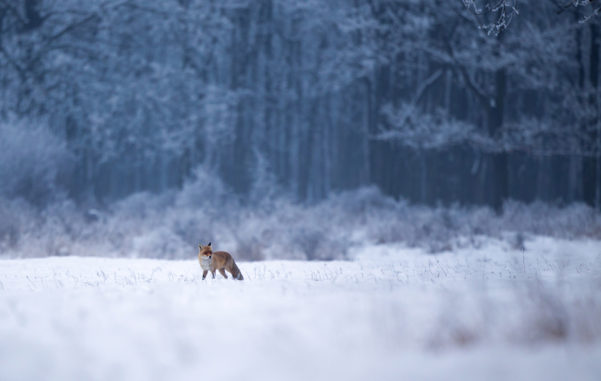
Nov 17, 2017 | Wildlife
As the cold winter months descend upon us, our first instinct is to head indoors for warmth and shelter. Animals have this same instinct during winter and will start looking to escape from the elements. They will usually look for holes, tunnels, logs, rock or leaf piles to burrow in but, if they are near neighborhoods, your home might look just as inviting to them.
Did you rake and bag your leaves this fall? Did you repair those holes in your deck, garage, or siding? Did you enclose your crawlspace and cap your chimney? If the answer is no, then you may have left an open invitation for critters to come into your home. Common winter wildlife invaders include squirrels, rats and mice, raccoons, and spiders. But don’t forget some lesser known winter animals, as well. Check out these four unusual winter pests and what you can do to prevent them.
OPOSSUMS:
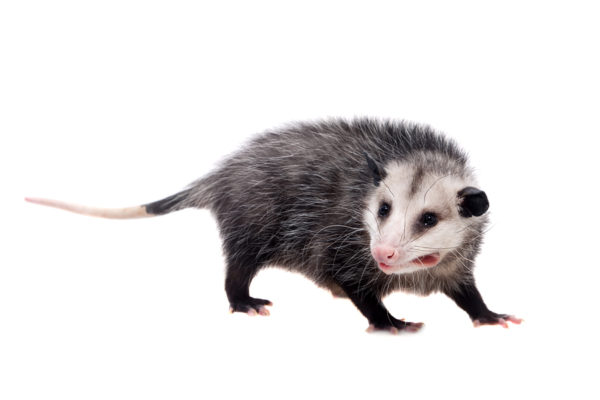
APPEARANCE:
- About 2 feet long
- About 10 lbs.
- Long, light grey hair
- Hairless round ears
- Scaly tail
- Five fingers on their front feet, four fingers and opposable thumbs on their rear feet
HABITAT:
- Establishes home within existing structures (hollow logs, garages, crawlspaces, under buildings, inside burrows)
- Lives close to their food sources
DIET:
- Omnivore
- Will eat anything it can find
- Usually eats fruit, grass, insects, mammals, birds, and fish
BEHAVIOR:
- Marsupial (carries young in a pouch)
- Sluggish and slow
- Nocturnal
- Excellent climbers
- Produces a repulsive smell
- Plays dead as a defensive mechanism
THREAT:
- Not dangerous to humans as long as they aren’t cornered
- May carry diseases of concern to humans (e.g. rabies) but transmission is extremely rare
- Always handle (dead or alive) with gloves and wash hands thoroughly afterwards
SIGNS:
- You see them out, especially at night
- Usually see or hear around garbage cans or in attics
- Damage to lawns and gardens from digging for food
- Eaten pet food or birdseed
PREVENTION:
- Opossums are protected species in many areas so check local laws and regulations before trapping or relocating
- Eliminate food sources by keeping pet food inside and removing uneaten birdseed at night
- Keep garbage cans closed and secure with bungee cords, cinder blocks, or latches
- Put garbage cans out for pickup in the morning rather than overnight
- Keep pets inside at night
- Keep outdoor grills and grease catch cans clean
- Secure under decks, eaves, and chimneys with wire mesh and use chimney caps
- Trim tree limbs to prevent roof access
- Enclose your crawlspace
FOXES:
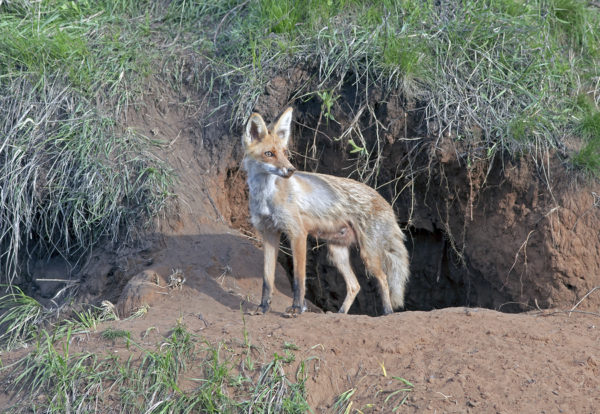
APPEARANCE:
- 3 to 3-1/2 feet in length
- Reddish brown to grey fur
- Tails have black or white tips
- Yellowish eyes
HABITAT:
- Will make dens under porches, decks or sheds
- Found in suburban areas and near farms
- Often seen near wooded areas, open fields and meadows
- Will dig their own dens or use abandoned burrows and hollow trees
DIET:
- Prey on small pets and livestock (rabbits, guinea pigs, chickens)
- Prefer rodents, rabbits, insects, and fruit
BEHAVIOR:
- Natural fear of humans
- Like to dig
THREAT:
- Not dangerous unless rabid (which is very rare)
- Dangerous if captured or handled (they will bite or attack)
SIGNS:
- See them (daytime or night)
- Small animals/pets are carried off
- Twisted droppings with hair or berries
- Distinct odor left behind (almost like a skunk)
PREVENTION:
- Keep pets indoors or in sturdy structures
- If they have established a den under or near your home:
- Loosely pack leaves, soil or mulch in the opening
- Place urine soaked kitty litter, a sweat soaked shirt, smelly socks, or old sneakers in or near the opening
- Spread capsicum-based repellent around the entry
- Bury an L-shaped footer around the perimeter of fencing or enclosures to prevent them from digging into them
- Scare foxes them away by making noise near their dens, shouting, or increasing activity near the den
- Get rid of food sources like garbage, compost piles, and outdoor pet food
COYOTES:
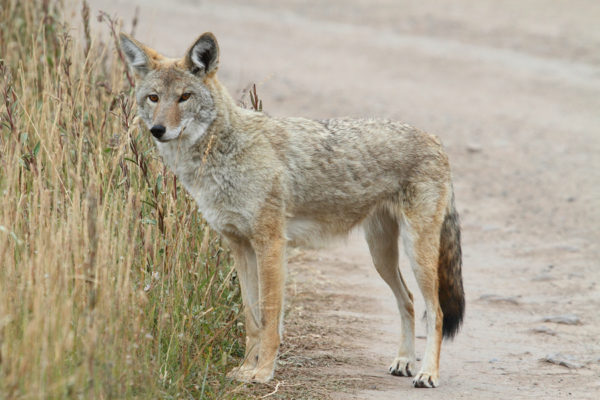
APPEARANCE:
- 4 to 5 feet in length
- 15 to 45 lbs
- Tawny grey fur with dark areas and a black strip along their back
- Backs of their ears are yellowish
- Throat and belly are white
- Tails have a black tip
HABITAT:
- Prefer forests, grasslands, deserts, and swampy areas (they are very adaptable)
- Accustomed to humans so they can be found in rural, urban, and suburban areas
DIET:
- Mainly prefer small animals (rabbits, squirrels, mice)
- Will also occasionally eat birds and insects
BEHAVIOR:
- Nocturnal – they usually hunt after dark and in the early morning
- Will kill house cats, small dogs, and livestock
- They run with their tails down (this distinguishes them from dogs and wolves)
THREAT:
- Can carry distemper, hepatitis, parvovirus, rabies, mange, and tularemia
- They have occasionally attacked humans if threatened
SIGNS:
- Spotting them, especially at night
- Hearing them (yip, yelp, howl, growl, and bark)
- Dead or missing animals
- Damage to gardens
- Tracks – more elongated than dogs and more uniform in shape
- Twisted droppings with hair and berries
- Signs of prey (carcasses or bones that have been eaten clean)
PREVENTION:
- Remove food sources like garbage cans and dumpsters or secure them with latches or straps
- Feed pets and birds during the day and clean up stray food
- Remove bird feeders at night as they will eat both the seeds and the animals who come to feed
- Keep an eye on pets and young children as coyotes will attack if they are left alone
ARMADILLOS:
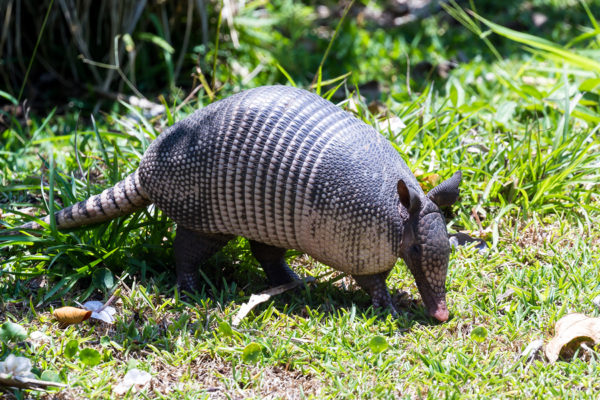
APPEARANCE:
- Anywhere from 6 inches to 5 feet in length
- 8 to 17 lbs
- Color ranges from black to red, grey, or yellowish patterns and coloring
- Tough shell with knobby scales
HABITAT:
- Live in wooded areas and prefer loose, sandy, or clay soil since it is easier to dig
- Will dig multiple burrows, some up to 15 feet deep
- Can burrow under patios and driveways
- Burrow entrances are usually hidden under brush, stumps, and rock piles
DIET:
- Insects, insect larvae, earthworms, snails, and scorpions
BEHAVIOR:
- Nocturnal – feed at night and hide in burrows during the day
- Excellent diggers
- Poor eyesight and hearing
- Move swiftly
- Good swimmers
THREAT:
- Not usually dangerous to humans
- Can carry the bacterium that causes leprosy but can only be transmitted by eating undercooked meat
SIGNS:
- Seeing them, especially at night
- Structural damage from burrowing under driveways and patios
- Damage to flowerbeds, gardens, and landscaping
PREVENTION:
- Eliminate food sources by decreasing the amount of water and fertilizer used on your lawn; this rich, moist soil brings worms and other insect larvae to the surface which attracts armadillos
- Install fences around gardens at least 2 feet high and 18 inches into the ground
- Remove brush, woodpiles, low lying bushes and shrubs as these are used to cover burrows
- Clean up any fallen berries or fruit
- Use a castor-oil based repellent around your yard
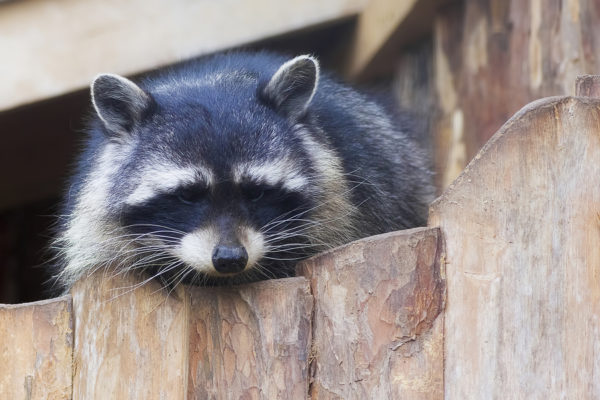
Oct 13, 2017 | Wildlife
Most of us have seen a raccoon, whether in person or as a cute, cuddly cartoon character. Unfortunately, these furry animals are not only dangerous to humans, but can cause significant damage and destruction to both your home and your yard. Raccoons are known to carry several bacterial diseases and parasites including rabies, salmonella, and roundworms.
Although raccoons are wild animals, they are becoming more and more common in urban areas as our population grows and their food and shelter sources diminish. They prefer to make their dens in hollowed out trees but these are fewer and far between in urban areas so they are forced to be more creative in their hunt for a home. Raccoons are now more often getting inside OUR homes, especially in the attic in search of shelter and food.
Raccoons are very dexterous animals and can use their hands to open doors, jars, bottles, and latches. They are also excellent climbers. These skills allow them to access our attics much more easily than other animals. But how do you know if you have a raccoon in or around your home? You can look for any of these signs:
- Sounds of movement in the attic like scurrying, chewing, crying, or growling, especially at night
- Tipped over trashcans
- Emptied or damaged bird feeders
- Damage to gardens
- Uncapped chimneys
- Torn shingles
- Urine or feces, especially in the attic
- Tracks which have 5 long toes and fingers, much like human prints
Once you have determined there is a raccoon in your attic, how do you get rid of it? While many people prefer to remove raccoons themselves, it’s not recommended. A wildlife removal company can not only safely remove the raccoons, but also clean up any contamination and offer exclusion methods to prevent them from returning. One thing to consider is that there is often a nest of babies along with the adult raccoon. Baby raccoons must be removed by hand. Wearing thick leather gloves, babies can be picked up by hand and carried out in a pillowcase. They can then be used to trap the adult raccoon or safely relocated. You can also trap the adult by scaring it into a pre-set trap or by catching it with a snare pole and putting it in a cage. Once the raccoons have been caught and removed, inspect your home to find entry points and then seal all areas to prevent raccoons and other pests from getting back into your home.
Most of us would prefer to avoid the process of removing raccoons (or having them removed) from our homes. So what can you do to prevent them from coming into your attic in the first place? Here are 5 tips for keeping raccoons out of your home:
- Hide your trash. Store trashcans and recycling bins indoors or in sealed areas such as locked sheds (raccoons can open unlocked doors even if they are closed). If you must keep your trashcans outdoors, use animal proof lids on them.
- Hide their food. Remove sources of food and shelter from your property. Cut down old trees that may be hollow. Remove bird feeders at night and be sure to clean underneath them. Don’t leave pet food and water containers out overnight. Keep pet food sealed and preferably inside.
- Eliminate their entry points. Inspect the outside of your home for possible access points and repair them. Look for holes in your roof or siding, loose siding and shingles, and holes in your porches or skirting. Cover chimneys with a wire mesh cover or cap. Cover any other exposed openings with wire mesh, as well. Install mesh beneath porches and decks and around your gardens. Consider crawlspace enclosure.
- Don’t forget your pets. Lock your pet doors at night. If your pets need access to outside overnight, consider investing in a pet door that operates by a remote sensor in your pet’s collar so that it stays locked until your pet activates the door.
- Light up the night. Raccoons are nocturnal animals and prefer the cover of darkness when they roam. Because most raccoons are used to humans, your regular porch light is often not enough to scare them off. Install motion-sensor floodlights in several areas around your home.
Jul 24, 2012 | Wildlife
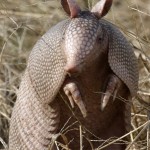 Out of the 20 known species of armadillo, only the nine-banded armadillo has strayed out of Latin America. During the 1880s, the animal appeared in Texas and has been pioneering into new dwellings ever since. Lately, the nine-banded armadillo has actually rooted itself as far east as Georgia & South Carolina and as far west as Illinois. The animals are occasionally noticed in Indiana and Iowa. A few researchers have proposed that escalating temperatures because of weather change might be permitting armadillos to expand toward further habitats.
Out of the 20 known species of armadillo, only the nine-banded armadillo has strayed out of Latin America. During the 1880s, the animal appeared in Texas and has been pioneering into new dwellings ever since. Lately, the nine-banded armadillo has actually rooted itself as far east as Georgia & South Carolina and as far west as Illinois. The animals are occasionally noticed in Indiana and Iowa. A few researchers have proposed that escalating temperatures because of weather change might be permitting armadillos to expand toward further habitats.
The gluttonous critters can create their homes in woodlands, grasslands, and even suburbs. Furthermore, fruitful females start breeding at barely one year old and can have litters of four babies every year. An armadillo’s dense frame is uncomplicatedly modified skin that acts as one approach that this abnormal animal shields itself. When an armadillo encounters a threat, it commonly dashes, digs, and bears down in the ground to stop them from being turned over. The three banded armadillo is the only species that can roll up into a ball for its own safety and its teardrop-shaped head plate fuses the gap so there are no cracks in the protective covering. Domestic dogs, wild cats, birds of prey, and humans are just a few of the threats to armadillos.
Our Wildlife Services Team specializes in the exclusion, removal, and control of wildlife nuisances. So if you see see or hear the scurrying of an armadillo, or another unwelcomed creature, our Wildlife Services Team can assist you in getting rid of the wildlife in your home! Call the Mouse! 888-466-7849
Now that you know a little more about Armadillos, do you think this armored animal is cool or creepy?
Cara Carver
[email protected]






 Out of the 20 known species of armadillo, only the nine-banded armadillo has strayed out of Latin America. During the 1880s, the animal appeared in Texas and has been pioneering into new dwellings ever since. Lately, the nine-banded armadillo has actually rooted itself as far east as Georgia & South Carolina and as far west as Illinois. The animals are occasionally noticed in Indiana and Iowa. A few researchers have proposed that escalating temperatures because of weather change might be permitting armadillos to expand toward further habitats.
Out of the 20 known species of armadillo, only the nine-banded armadillo has strayed out of Latin America. During the 1880s, the animal appeared in Texas and has been pioneering into new dwellings ever since. Lately, the nine-banded armadillo has actually rooted itself as far east as Georgia & South Carolina and as far west as Illinois. The animals are occasionally noticed in Indiana and Iowa. A few researchers have proposed that escalating temperatures because of weather change might be permitting armadillos to expand toward further habitats.